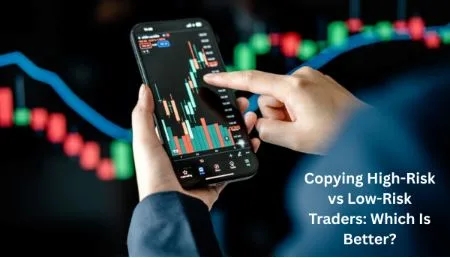Copying High-Risk vs Low-Risk Traders: Which Is Better?
In the modern financial world, the concept of copy trading has made it easier for less experienced traders to copy the moves of expert traders than ever before. Isn’t it fascinating that with just a few clicks, you can follow the strategy of someone else?
But the biggest question that comes to mind for every trader while choosing the expert is: Should you copy high-risk traders who aim for big returns or stick with low-risk traders who play it safe?
Well, honestly, both of these approaches have their own benefits and risks. In this blog, we’ll break it down in simple terms to help you make a smarter decision. But first, let’s begin with the basics.
What is Copy Trading?
In forex, copy trading is a trading strategy where you copy the trades of an experienced person, often automatically. This means that if they buy EUR/USD, then you buy it too. Similarly, if they close a position, the same happens to yours. You can think of this as putting your trading on autopilot mode, where you are simply following the strategy of more experienced traders.
And the best part of copy trading platform is that you can choose the traders of your choice among a variety of copy providers (experienced traders) based on their historical performance, risk level, trading styles, and the preferred asset/market.
Who are high-risk traders?
High-risk traders are usually looking for maximum profit in the shortest time possible. They often trade with high leverage, make quick decisions, and aren’t afraid of large losses along the way. However, without proper forex risk management, this approach can quickly wipe out an account.
Here are some of the pros of copying high-risk traders:
- Chances for better/higher returns: These traders may grow their accounts quickly, so you can also have higher returns in less time.
- Excitement: The fast pace and high-stakes moves can be thrilling to watch.
- Good at times of strong trends: The fast pace and high-stake moves can be thrilling.
Now, let’s have a look at the cons of copying high-risk traders:
- Bigger drawdowns: Yes, it can have potential for higher returns in a shorter time, but it cannot be denied that you can also lose a chunk of money at the same time.
- Emotional rollercoaster: Watching the balance swing wildly can be really stressful for some.
- Short-term focus: The high-risk trading strategies might not work well in all market conditions.
After learning about the pros and cons of copying high-risk traders, you can say that these traders are a bit like those speedy sports cars, which are fast and flashy, but they can spin out of control within seconds if the road gets slippery.
Who are low-risk traders?
Low-risk traders are completely the opposite of the above. They focus on the preservation of the capital and growing it slowly over the period of time. They usually risk a small percentage of their account’s capital per trade, avoid over-leveraging, and use tighter risk management strategies.
The pros of copying low-risk traders are:
- No dramatic drawdowns: Since these traders put a smaller percentage of capital of their accounts in traders, your account would never drop dramatically overnight.
- Easier if you want to stick with long-term trading: You can experience lower pressure as the emotional toll is much lower. This is good if you want to go ahead with long-term trading.
- Consistent performance: Usually, such traders aim for stable and gradual gains, so you are not risking much and can actually get consistent results.
Here are some of the major cons of copying low-risk traders:
- Lower profits: If they are playing it safe and putting a small amount of money, then you can’t expect to double your money in a month.
- Slower results: They believe that patience is the key, thus, you know that the returns may take time to show.
- Can still lose: Yes, there are lower risk chances, but it doesn’t mean that trading becomes risk-free for you. You are still at risk.
This means that the low-risk traders are like family sedans, who are reliable and safer, but maybe not as exciting or fast.
Wait! We are still left with one of the major forex risk management questions, i.e., which one should you choose?
Let’s see the answer now.
Which one should you copy?
So, the honest answer to this question is that there is no exact answer that works for all.
And, the real answer depends on your trader personality.
While choosing your ideal match, you need to consider a few things, like:
#1 What is your risk tolerance?
You need to check if you can handle big ups or downs in your balance. If your answer is no, then low-risk traders are a better fit as you prefer slow, steady growth with less stress. But, if it’s the opposite and you are ready to put a large sum of money at risk, then high-risk traders are ideal for you.
#2 How much are you investing?
If you’re someone who is starting with a small amount and is okay with the possibility of losing it, you might feel comfortable copying higher-risk strategies. But if you’re putting in a large sum of money you can’t afford to lose, lower-risk options are safer.
#3 What Are Your Goals?
Are you someone who is looking for short-term gains? Or someone who is interested in long-term growth? Depending on your answer, you may choose accordingly, as high-risk traders may help you achieve faster results, but low-risk traders offer more sustainability over time.
How about a balanced approach?
There are some investors who choose to copy a mix of both high-risk and low-risk traders.
But why?
This is because it can help balance out your portfolio. By using the high-risk traders, you can have potential short-term gains, and with the low-risk traders, you can have a sense of stability.
Understand this with a simple example:
- Allocate 70% of your copy portfolio to low-risk traders for stability.
- Use the remaining 30% for higher-risk, with the high-reward strategies.
This way, you can get the best of both worlds.
Conclusion
To conclude, copy trading can be a great tool, especially if you are a newbie to the market, have little experience in the particular market, or simply have restrictions on time. But no matter who you copy, a high-risk or low-risk trader, you need to remember that there is no such thing called as guaranteed profits.
So, you need to take your time to research, monitor performance regularly, and don’t be afraid to make changes if something isn’t working for you.




